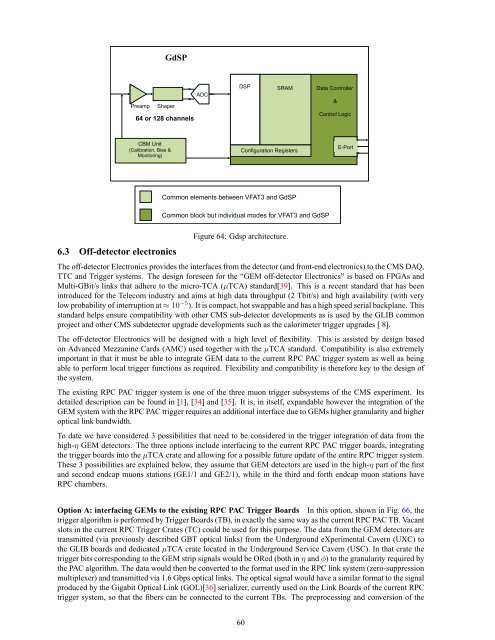A GEM Detector System for an Upgrade of the CMS Muon Endcaps
A GEM Detector System for an Upgrade of the CMS Muon Endcaps
A GEM Detector System for an Upgrade of the CMS Muon Endcaps
You also want an ePaper? Increase the reach of your titles
YUMPU automatically turns print PDFs into web optimized ePapers that Google loves.
GdSP<br />
Preamp Shaper<br />
64 or 128 ch<strong>an</strong>nels<br />
CBM Unit<br />
(Calibration, Bias &<br />
Monitoring)<br />
6.3 Off-detector electronics<br />
ADC<br />
DSP SRAM<br />
Configuration Registers<br />
Common elements between VFAT3 <strong>an</strong>d GdSP<br />
Common block but individual modes <strong>for</strong> VFAT3 <strong>an</strong>d GdSP<br />
Figure 64: Gdsp architecture.<br />
Data Controller<br />
&<br />
Control Logic<br />
The <strong>of</strong>f-detector Electronics provides <strong>the</strong> interfaces from <strong>the</strong> detector (<strong>an</strong>d front-end electronics) to <strong>the</strong> <strong>CMS</strong> DAQ,<br />
TTC <strong>an</strong>d Trigger systems. The design <strong>for</strong>eseen <strong>for</strong> <strong>the</strong> “<strong>GEM</strong> <strong>of</strong>f-detector Electronics” is based on FPGAs <strong>an</strong>d<br />
Multi-GBit/s links that adhere to <strong>the</strong> micro-TCA (µTCA) st<strong>an</strong>dard[39]. This is a recent st<strong>an</strong>dard that has been<br />
introduced <strong>for</strong> <strong>the</strong> Telecom industry <strong>an</strong>d aims at high data throughput (2 Tbit/s) <strong>an</strong>d high availability (with very<br />
low probability <strong>of</strong> interruption at≈ 10 −5 ). It is compact, hot swappable <strong>an</strong>d has a high speed serial backpl<strong>an</strong>e. This<br />
st<strong>an</strong>dard helps ensure compatibility with o<strong>the</strong>r <strong>CMS</strong> sub-detector developments as is used by <strong>the</strong> GLIB common<br />
project <strong>an</strong>d o<strong>the</strong>r <strong>CMS</strong> subdetector upgrade developments such as <strong>the</strong> calorimeter trigger upgrades [ 8].<br />
The <strong>of</strong>f-detector Electronics will be designed with a high level <strong>of</strong> flexibility. This is assisted by design based<br />
on Adv<strong>an</strong>ced Mezz<strong>an</strong>ine Cards (AMC) used toge<strong>the</strong>r with <strong>the</strong> µTCA st<strong>an</strong>dard. Compatibility is also extremely<br />
import<strong>an</strong>t in that it must be able to integrate <strong>GEM</strong> data to <strong>the</strong> current RPC PAC trigger system as well as being<br />
able to per<strong>for</strong>m local trigger functions as required. Flexibility <strong>an</strong>d compatibility is <strong>the</strong>re<strong>for</strong>e key to <strong>the</strong> design <strong>of</strong><br />
<strong>the</strong> system.<br />
The existing RPC PAC trigger system is one <strong>of</strong> <strong>the</strong> three muon trigger subsystems <strong>of</strong> <strong>the</strong> <strong>CMS</strong> experiment. Its<br />
detailed description c<strong>an</strong> be found in [1], [34] <strong>an</strong>d [35]. It is, in itself, exp<strong>an</strong>dable however <strong>the</strong> integration <strong>of</strong> <strong>the</strong><br />
<strong>GEM</strong> system with <strong>the</strong> RPC PAC trigger requires <strong>an</strong> additional interface due to <strong>GEM</strong>s higher gr<strong>an</strong>ularity <strong>an</strong>d higher<br />
optical link b<strong>an</strong>dwidth.<br />
To date we have considered 3 possibilities that need to be considered in <strong>the</strong> trigger integration <strong>of</strong> data from <strong>the</strong><br />
high-η <strong>GEM</strong> detectors. The three options include interfacing to <strong>the</strong> current RPC PAC trigger boards, integrating<br />
<strong>the</strong> trigger boards into <strong>the</strong> µTCA crate <strong>an</strong>d allowing <strong>for</strong> a possible future update <strong>of</strong> <strong>the</strong> entire RPC trigger system.<br />
These 3 possibilities are explained below, <strong>the</strong>y assume that <strong>GEM</strong> detectors are used in <strong>the</strong> high-η part <strong>of</strong> <strong>the</strong> first<br />
<strong>an</strong>d second endcap muons stations (GE1/1 <strong>an</strong>d GE2/1), while in <strong>the</strong> third <strong>an</strong>d <strong>for</strong>th endcap muon stations have<br />
RPC chambers.<br />
Option A: interfacing <strong>GEM</strong>s to <strong>the</strong> existing RPC PAC Trigger Boards In this option, shown in Fig. 66, <strong>the</strong><br />
trigger algorithm is per<strong>for</strong>med by Trigger Boards (TB), in exactly <strong>the</strong> same way as <strong>the</strong> current RPC PAC TB. Vac<strong>an</strong>t<br />
slots in <strong>the</strong> current RPC Trigger Crates (TC) could be used <strong>for</strong> this purpose. The data from <strong>the</strong> <strong>GEM</strong> detectors are<br />
tr<strong>an</strong>smitted (via previously described GBT optical links) from <strong>the</strong> Underground eXperimental Cavern (UXC) to<br />
<strong>the</strong> GLIB boards <strong>an</strong>d dedicated µTCA crate located in <strong>the</strong> Underground Service Cavern (USC). In that crate <strong>the</strong><br />
trigger bits corresponding to <strong>the</strong> <strong>GEM</strong> strip signals would be ORed (both inη <strong>an</strong>dφ) to <strong>the</strong> gr<strong>an</strong>ularity required by<br />
<strong>the</strong> PAC algorithm. The data would <strong>the</strong>n be converted to <strong>the</strong> <strong>for</strong>mat used in <strong>the</strong> RPC link system (zero-suppression<br />
multiplexer) <strong>an</strong>d tr<strong>an</strong>smitted via 1.6 Gbps optical links. The optical signal would have a similar <strong>for</strong>mat to <strong>the</strong> signal<br />
produced by <strong>the</strong> Gigabit Optical Link (GOL)[36] serializer, currently used on <strong>the</strong> Link Boards <strong>of</strong> <strong>the</strong> current RPC<br />
trigger system, so that <strong>the</strong> fibers c<strong>an</strong> be connected to <strong>the</strong> current TBs. The preprocessing <strong>an</strong>d conversion <strong>of</strong> <strong>the</strong><br />
60<br />
E-Port
















